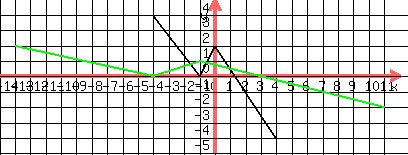Question 1165442: The graph of f(x) is shown below. https://latex.artofproblemsolving.com/d/b/a/dba24dce7c2734af95b18f61b73b2a32f213cd79.png
For each point (a,b) on the graph of y = f(x), the point ( 3a - 1, b/2) is plotted to form the graph of another function y = g(x). For example, (0,2) lies on the graph of y = f(x), so (3 * 0 - 1, 2/2) = (-1,1) lies on the graph of y = g(x).
(a) Plot the graph of y = g(x). Include the diagram in your solution.
(b) Express g(x) in terms of f(x).
(c) Describe the transformations that you would apply to the graph of y = f(x) to obtain the graph of y = g(x). For example, one transformation might be to stretch the graph horizontally by a factor of 5.
Please answer in detail!
Answer by Edwin McCravy(20067)   (Show Source): (Show Source):
You can put this solution on YOUR website!
This is the graph of f(x):
 We translate the endpoints of the line segments in f(x) to line segments
in g(x), using the given point transformation (a,b) ---> (3a-1, b/2)
(-4,4) in f(x) corresponds to (-13,2) in g(x).
(-1,0) in f(x) corresponds to (-4,0) in g(x).
(0,2) in f(x) corresponds to (-1,1) in g(x)
(4,-4) in f(x) corresponds to (11,-2) in g(x)
We translate the endpoints of the line segments in f(x) to line segments
in g(x), using the given point transformation (a,b) ---> (3a-1, b/2)
(-4,4) in f(x) corresponds to (-13,2) in g(x).
(-1,0) in f(x) corresponds to (-4,0) in g(x).
(0,2) in f(x) corresponds to (-1,1) in g(x)
(4,-4) in f(x) corresponds to (11,-2) in g(x)
 f(x) is in black, g(x) is in green.
We observe what happens when point (a,b) on f(x) becomes (3a-1,b/2) on g(x)
Each x-coordinate "a" becomes "3a", and then becomes "3a-1"
When "a" becomes "3a", that indicated a horizontal stretch by a factor of 3.
That is accomplished by replacing x in f(x) by 1/3x,
So that gives us
f(x) is in black, g(x) is in green.
We observe what happens when point (a,b) on f(x) becomes (3a-1,b/2) on g(x)
Each x-coordinate "a" becomes "3a", and then becomes "3a-1"
When "a" becomes "3a", that indicated a horizontal stretch by a factor of 3.
That is accomplished by replacing x in f(x) by 1/3x,
So that gives us
 for "a" becoming "3a".
Then when "3a" becomes "3a-1", that indicates a horizontal shift by 1 unit
left. That is accomplished by replacing x by x+1.
So that gives us
for "a" becoming "3a".
Then when "3a" becomes "3a-1", that indicates a horizontal shift by 1 unit
left. That is accomplished by replacing x by x+1.
So that gives us
 for "3a" becoming "3a-1".
Now each y-coordinate "b" becomes "b/2".
When each y-coordinate "b" becomes "b/2", the graph is shrunk vertically
by a factor of 1/2. That is accomplished by multiplying the entire function
by 1/2,
So that gives us
for "3a" becoming "3a-1".
Now each y-coordinate "b" becomes "b/2".
When each y-coordinate "b" becomes "b/2", the graph is shrunk vertically
by a factor of 1/2. That is accomplished by multiplying the entire function
by 1/2,
So that gives us
 for b becoming b/2.
So that now completes g(x) in terms of f(x), so we have:
for b becoming b/2.
So that now completes g(x) in terms of f(x), so we have:
 You will notice that the green graph is the black graph stretched
horizontally by a factor of 3, then shrunk vertically by a factor of 1/2 and
shifted left by 1 unit.
Edwin
You will notice that the green graph is the black graph stretched
horizontally by a factor of 3, then shrunk vertically by a factor of 1/2 and
shifted left by 1 unit.
Edwin
|
|
|